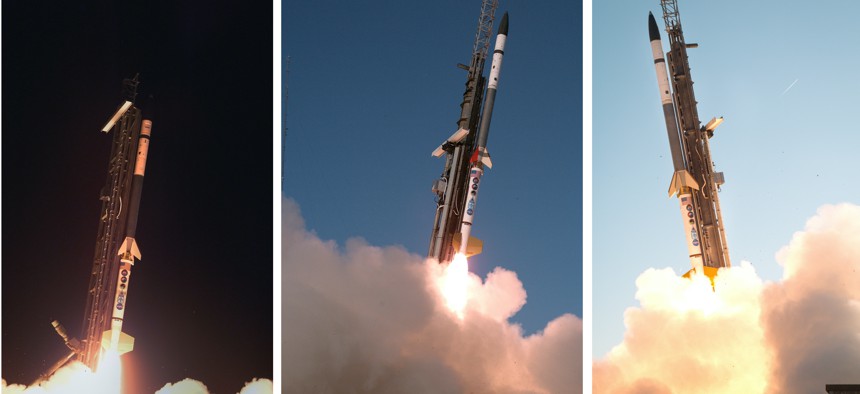
Three Navy launches from NASA’s Wallops Flight Facility in Virginia reached hypersonic speeds Oct. 20, 2021, as part of a “High Operational Tempo for Hypersonics flight campaign.” Courtesy of Sandia National Laboratories
One of Four Boosters Fails in Rapid-Fire Hypersonic Tests
Three launches got off successfully from Virginia; investigations have begun into the Alaska failure.
Just days after news broke that a Chinese hypersonic test vehicle had reached orbit, the U.S. Navy and Army launched several test rockets as part of their own effort to develop maneuverable high-speed missiles. One failed.
“Yesterday, three launches that reached hypersonic speeds were conducted to inform our development of hypersonic capabilities. Specifically, these rockets contained experimental payloads that provided data on the performance of materials and systems in a realistic hypersonic environment,” Navy spokesman Lt. Lewis Aldridge said in a statement Thursday.
Those Wednesday launches, from NASA’s Wallops Flight Facility in Virginia, were part of a “High Operational Tempo for Hypersonics flight campaign” by Sandia National Laboratories, a Navy statement said.
But another planned test—a “data collection” experiment for hypersonic technology development in Kodiak, Alaska—was scuttled on Thursday when the rocket’s booster failed.
“The booster stack used in the test was not part of the hypersonic program and is not related to the Common Hypersonic Glide Body. The missile booster is used for testing purposes only,” Pentagon spokesman Lt. Cmdr. Tim Gorman said in a statement Thursday.
The test was conducted at the Pacific Spaceport Complex-Alaska. Officials are investigating the cause of the failure.
The Wednesday and Thursday tests are part of an effort by the Army’s Hypersonic Program Office and Navy’s Strategic Systems Programs to develop a common hypersonic missile. The Navy has designed a Common Hypersonic Glide Body and booster and the Army is leading its production.
“Experiments and tests—both successful and unsuccessful—are the backbone of developing highly complex, critical technologies at tremendous speed, as the department is doing with hypersonic technologies,” Gorman said. “This flight test is part of an ongoing series of flight tests as we continue to develop this technology.”
Patrick Tucker contributed to this post.




